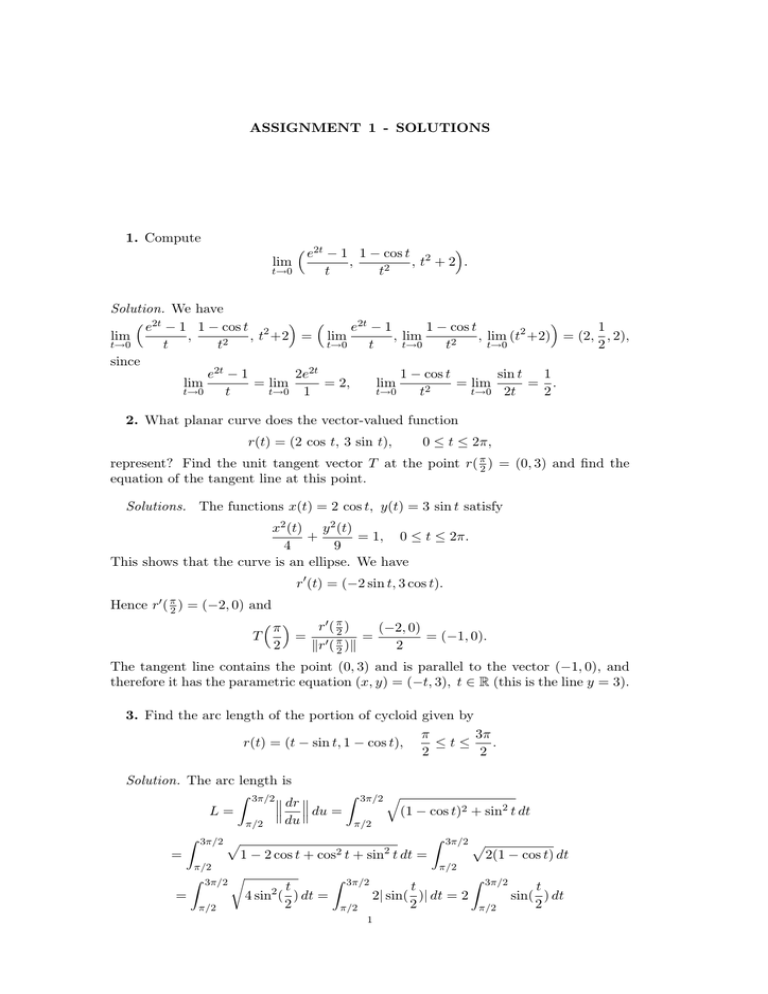ASSIGNMENT 1 - SOLUTIONS 1. Compute − 1 e
advertisement

ASSIGNMENT 1 - SOLUTIONS 1. Compute lim t→0 e2t − 1 1 − cos t 2 , t + 2 . , t t2 Solution. We have e2t − 1 1 − cos t e2t − 1 1 − cos t 1 2 2 lim , , t +2 = lim , lim , lim (t +2) = (2, , 2), t→0 t→0 t→0 t→0 t t2 t t2 2 since e2t − 1 2e2t 1 − cos t sin t 1 lim = lim = 2, lim = lim = . t→0 t→0 1 t→0 t→0 2t t t2 2 2. What planar curve does the vector-valued function r(t) = (2 cos t, 3 sin t), 0 ≤ t ≤ 2π, represent? Find the unit tangent vector T at the point r( π2 ) = (0, 3) and find the equation of the tangent line at this point. Solutions. The functions x(t) = 2 cos t, y(t) = 3 sin t satisfy x2 (t) y 2 (t) + = 1, 0 ≤ t ≤ 2π. 4 9 This shows that the curve is an ellipse. We have r0 (t) = (−2 sin t, 3 cos t). Hence r0 ( π2 ) = (−2, 0) and π r0 ( π ) (−2, 0) T = 0 π2 = = (−1, 0). 2 kr ( 2 )k 2 The tangent line contains the point (0, 3) and is parallel to the vector (−1, 0), and therefore it has the parametric equation (x, y) = (−t, 3), t ∈ R (this is the line y = 3). 3. Find the arc length of the portion of cycloid given by π 3π r(t) = (t − sin t, 1 − cos t), ≤t≤ . 2 2 Solution. The arc length is Z 3π/2 Z 3π/2 q dr L= (1 − cos t)2 + sin2 t dt du = du π/2 π/2 Z 3π/2 p Z 3π/2 p = 1 − 2 cos t + cos2 t + sin2 t dt = 2(1 − cos t) dt π/2 Z 3π/2 = π/2 π/2 r t 4 sin ( ) dt = 2 2 Z 3π/2 π/2 t 2| sin( )| dt = 2 2 1 Z 3π/2 π/2 t sin( ) dt 2 2 ASSIGNMENT 1 - SOLUTIONS √ √ h √ 2 2 t i3π/2 = −4(− = 2 −2 cos( ) ) − 4(− ) = 4 2. 2 t=π/2 2 2 4. Find an arc length parametrization for the circular helix r(t) = (2 cos t, 2 sin t, t) with reference point r(0). Solution. An arc length parameter is Z t Z t dr s= k(−2 sin u, 2 cos u, 1)k du du = 0 du 0 Z tq √ = 4( sin2 u + cos2 u) + 1 du = 5 t. 0 Then t = √s 5 and an arc length parametrization with reference point r(0) is s s s r(s) = (2 cos √ , 2 sin √ , √ ). 5 5 5 5. What curve does the vector-valued function r(t) = (t, −t2 ), t ∈ R, represent? Find the unit normal vector N , the curvature κ and the osculating circle at the point r(0). Solution. From x = t, y = −t2 it follows that y = −x2 which is a parabola. We compute r0 (t) = (1, −2t). The unit tangent vector at t is T (t) = Then (1, −2t) r0 (t) =√ . kr0 (t)k 1 + 4t2 −4t −2 , , T 0 (0) = (0, −2). (1 + 4t2 )3/2 (1 + 4t2 )3/2 The unit normal vector at t = 0 is given by T 0 (0) N (0) = = (0, −1). kT 0 (0)k The curvature at t = 0 is kT 0 (0)k 2 k(0) = 0 = = 2. kr (0)k 1 1 The radius of the osculating circle is ρ = k(0) = 21 and the centre is at r(0) + ρN (0) = (0, 0) + 21 (0, −1) = (0, − 21 ). T 0 (t) =





